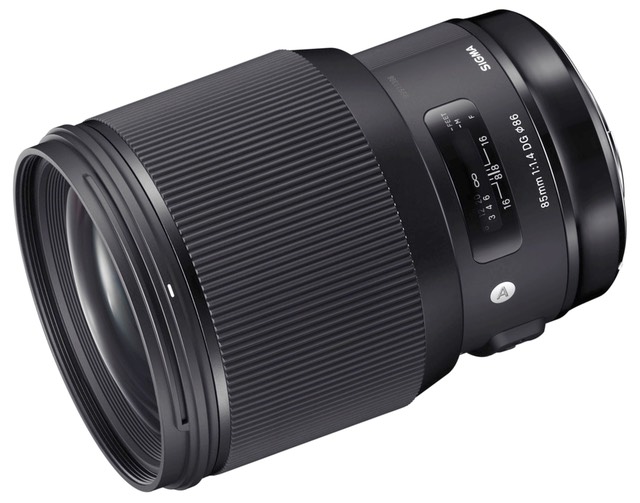
What is It?
The Sigma 85mm f/1.4 DG Art is one of the lenses I get asked most about. There's a general perception that the Nikkor primes (older f/1.4 and newer f/1.8) aren't all they can be—not that I agree with that—and then there's Sigma's pricing compared to Nikon's.
I thought the 135mm f/1.8 Art was big and heavy, but surprisingly, the 85mm f/1.4 Art is right up there with it: 39.9 ounces (1130g), 5" (126.2mm) long, and 3.7" (94.7mm) in diameter. It's a handful.
And again it's because of all that glass inside: 14 elements in 12 groups, but those front six elements are pretty big, and there's a couple of fat boys out back, too. A lot of complex lens polishing and special glass, including one true aspherical at the back, two SLD elements nearer the front.
Apertures run from f/1.4 to f/16. There are two DOF markings on the focus window, one for f/8, the other for f/16. The aperture opening is nine-bladed, and rounded. I should point out that the aperture is electronically controlled on Nikons (e.g. E-type), so watch camera compatibility.
Focus is marked in feet and meters, and unlike the 135mm I tested, the foot markings are a little easier to see, though still somewhat dim. Maximum magnification is a pokey 1:8.5, which means that close focus is a slightly long 33.5" (.85m). Focus pulls in a bit over a quarter of turn from near to far.
There's one switch on the side of the lens, for AF/MF.
My sample was made in 2016.
The 85mm f/1.4 Art is made in Japan and sells for US$1199. It's available in Canon EF, Nikon F, Sigma SA, and Sony FE mounts.
Source of the reviewed lens: B&H loaner
How's it Handle?
Again, primes are easy. Is the focus ring large and easy to find? Yes. Is it smooth? Yes. Are the switches (if any) stiff. Yes.
Like the 135mm, hanging the 85mm f/1.4 Art off the front of the lighter DSLRs (e.g. D610, D750) makes for a front heavy concoction. Not at all with the D5. I'm a support-the-lens-with-my-left-hand-under-it kind of guy, so neither is a problem for me. Still, a heavy camera and heavy lens means you want to pay attention to how you carry it.
How's it Perform?
Focus: A definite perceptible slide-to-focus, and noisier than the other Art primes I tested. Occasional bounce back to focus after overshoot, particularly in the all-Auto modes on a couple of my Nikon DSLRs (very noticeable on the D7500, not really on the D5). Slower Live View autofocus than the other Sigmas, too.
Sharpness: You know how Japanese knife blades have a reputation for be-careful-not-to-touch sharp? Well, this lens gave me that impression right off. Which I wasn't expecting from the published MTF charts (I was expecting good, but not really good). Wide open the lens is very good at resolving detail, and I'd tend to say that sticks right out to the borders and maybe even the extreme corners. There's a bit of contrast loss compared to what it does at f/2.8, though. This Sigma measured the highest I've tested to date for 85mm in the center at f/2.8. Surprisingly, the corners were only a little better than at f/1.4. Indeed, the corners didn't hit their highest mark until f/5.6, at which point the center had lost a little sharpness from f/2.8.
But measurements aren't what you want to take away from the above. The lens is very usably sharp for anything wide open, it gets better until the center is don't-cut-yourself sharp at f/2.8 and the corners pull in at f/4 and f/5.6. I'm not afraid to use this lens at any non-diffracted aperture, with focus at any point in the frame. Probably the best 85mm performance I've seen to date (caveat: haven't tested the Zeiss Otus yet). I'd clearly pick this lens over my Nikkors if it weren't for one thing: size and weight.
I can see coma in the corners, though. Regularly shaped objects lose a bit of their regularness out at the extremes.
One other thing to be aware of: this lens has a bit of a focus shift to the background as you stop down. It's not a big shift, but you're at telephoto lengths and if you're using this lens in close range, DOF may not hold you.

Wide open near close focus distance.

The crop. The DOF is so shallow that individual tufts go in and out of focus. The lens is sharp, but you'd better be sure of your focus.

Same scene at f/8. Compare to f/1.8, above. That's actually a fairly well refined focus-to-out-of-focus transition.
Linear distortion: This lens is near completely free of linear distortion. What little there is is pincushion, and slightly eccentric. But it's really not enough that most people would ever consider correcting.
Vignetting: Unlike the other Sigma Art primes I've been testing, the 85mm fits more into the pattern I'd expect. There's about one and two-thirds stop vignetting wide open, and this drops to a stop at f/2, and well below a half stop beyond that. I'm very comfortable with all that. When I use a telephoto lens at f/1.4 it's generally for subject isolation, and a little vignetting is actually welcome. At these levels (and with no linear distortion), correction is fairly simple and pain-free if you really need to do that.
Chromatic abberation: Laterally, there's exactly zero to be worried about. Surprisingly little chromatic aberration. So low I thought maybe I had set correction on in the converter accidentally. As you'd expect, there's longitudinal aberration; I've yet to see a fast prime without it. Again a surprise, though: it corrects very fast. I'd really only worry about it a bit at f/1.4 and maybe f/2; it's mostly gone by f/5.6.
Bokeh: Pretty nice, actually. Less edge brightness than I'm used to with Sigmas, to the point where you have to look for it to see it. Almost no onion skinning. The coma does tend to distort image blur circles a bit in the corners. Still, if you're buying this lens for isolation and want good characteristics in the out of focus background, I think you'll be happy with this lens.
Final Thoughts
This is one of the nicer lenses in the Sigma Art prime series. Definitely a lens I want to use some more, despite the big size and weight. And 86mm filters? Eek. Good thing I don't generally use filters these days.
But really, here's what you need to know: very usable wide open, going to bring a smile on your face from f/2 to f/5.6, and very few flaws that you need to be aware of or do anything about. I'm very impressed with this lens, and it may find a place in my prime set right between my 58mm f/1.4G and 105mm f/1.4E. It'll keep those two lenses honest ;~).
I'm not sure the focus is truly sports-level reliable in low light, at least on the D850. There's just a bit more slide-to-focus than I'd like, but that said, my 85mm Nikkors aren't all that fast to focus, either. I can live with the focus performance.
The one thing event shooters need to watch, though, is that focus shift. It's not big, but it's there. If you're not nailing the eyeballs with your focus plane and you're stopped down, I'm betting that the focus shift got you. This, by the way, Nikon, is one reason why I've asked several times that AF Fine Tune on/off be button assignable. I could fix most of those small focus misses by making a tuning adjustment for, say, f/5.6, and just hold in a button when I'm at f/5.6 and leave my finger off when I'm at f/1.4.
Recommended (2018 to present)